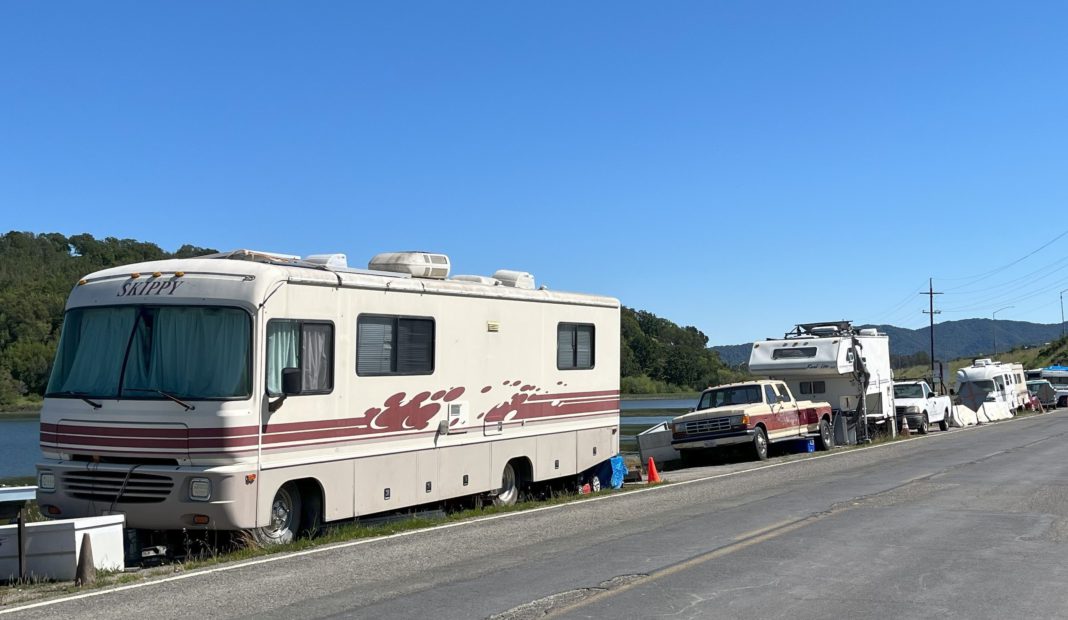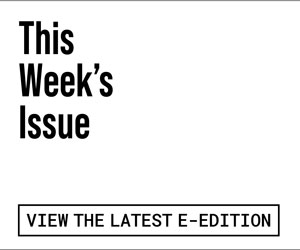Part two of a two-part report. Read part one here.
Just the mention of Binford Road evokes strong reactions from folks in Marin County—positive, negative and sometimes downright caustic.
Many consider the RV homeless encampment a shining example of government working compassionately to provide much needed services to people down on their luck. Others see it as a blight on their predominantly affluent community.
Last week, I spent the morning riding with Dep. Mike Thompson, homelessness outreach officer for the Marin County Sheriff’s Office, who spends a good portion of his shifts on Binford Road. We did this same ride in May 2023, and Thompson’s reasonable, caring approach toward his work with the Binford Road community remains unchanged.
Like most mornings, it was quiet on this stretch of street just outside of Novato city limits in unincorporated Marin. We saw only a few of the 78 homeless people who live in RVs, cars, trucks and even a few tents on both sides of the road. Many of the residents work during the day.
Thompson stopped beside a large bus. I know the young man who lives there, a tinkerer, though some might call him a hoarder. His site overflows with possessions, including used bike parts that he fashions into new bicycles.
A shiny black truck pulled up beside Thompson’s cruiser, and the middle-aged driver—not a Binford resident—rolled down his tinted window and shouted a question. Thompson told the man that he was busy, and we drove away, but the interaction clearly disturbed the deputy.
“I’ve never seen that guy before,” Thompson said. “He was like, ‘What are they doing with the bike thief?’ Well, how do you know he’s a bike thief? I’m not going to engage.”
However, Thompson’s position does keep him front and center with disgruntled people who want to discuss the Binford Road encampment. He typically hears them out.
“I think they’re just uninformed,” Thompson said. “For the average person who doesn’t know anything about what it really means to be homeless, all they know about homelessness is what they see. Not so much in Marin, but in the East Bay or San Francisco, what you see seems to be trash, crime, drug abuse and unchecked mental illness. Then that’s what they know homelessness to be.”
Binford Road doesn’t come close to resembling those hotspots featured often in the media, such as San Francisco’s Tenderloin or the frequently cleared camps in Oakland and Berkeley.
Thompson reiterated what he told me last year—there’s relatively little crime on Binford. An occasional fire or drug bust is about the worst of it.
Still, the RV encampment has its own set of unique circumstances, including lack of drinking water, personal property stored outside of vehicles near an environmentally sensitive marsh and lawsuits filed by a few of the residents.
Yet, Marin County officials remain committed to diligently working with its homeless population, connecting them with services and housing. This, despite last month’s U.S. Supreme Court ruling overturning legal protections for homeless people and California Gov. Gavin Newsom last week urging cities and counties to clear encampments.
For years, homeless folks have taken up residence on Binford Road, but the population swelled during the pandemic. The county decided not to enforce the 72-hour parking limit, knowing that the ordinance pushes homeless people to become nomadic, making it more difficult for social workers, often called case managers, to find them.
“The high-water mark was 117 people, and currently we have 78 living on Binford Road,” Marin County Supervisor Eric Lucan said. “I’m pleased to see the number of individuals that we’ve been able to support and house.”
Last year, Marin secured $1.6 million over three years from California’s Encampment Resolution Funding, with the ultimate objective to house all the Binford residents. The state announced in April that the county will soon receive another grant for more than $3.72 million to “resolve” the Binford encampment.
The county has been using the initial award for enhanced outreach, housing-based case management and other direct support. New staff has come on board, and contracts were awarded to local nonprofit agencies, including Downtown Streets Team and Community Action Marin.
Since last year, 27 former Binford Road residents have received housing, according to Gary Naja-Riese, director of Marin County Homelessness & Coordinated Care. An additional 22 residents are at various stages on the path to housing.
It’s not unusual for people to spend years on the county’s “waiting list” for permanent supportive housing—housing combined with voluntary support services—which is prioritized based on a person’s need.
Zoë Neil, director of Downtown Streets Team, said her staff gets creative to find different ways to house folks. It’s a time-intensive process that often achieves results for their clients on Binford Road.
“We look at alternatives to permanent supportive housing, like rapid rehousing, which provides short term rental assistance and services to people with stable incomes,” Neil said. “The outreach folks are really trying to navigate the best possible pathway to housing.”
Another solution has included connecting some people with their families, who can provide a place for them to live, explains Neil. Or if someone enjoys the recreational vehicle lifestyle, the outreach manager can try to help them find a spot in an RV park.
Even while the county has multiple departments and outside contractors working to provide services for people on Binford, community activists say their efforts sometimes fall short.
In May, three residents filed a lawsuit against the county in federal court for seizing and destroying their property. Although the county provided 15 days’ notice of the “clean up” and stored the property for 90 days before destroying it, residents said that valuable items such as dog enclosures, shade awnings and solar panels were taken.
Clearly, a common sense approach exists. There’s a difference between seizing a hoarder’s cache and removing practical, necessary items. The county, it appears, will try striking that balance going forward.
A notice distributed to residents last week states that clean ups will now occur on the second and fourth Thursdays each month. Thompson said that with this new system, they will be more flexible. As we drove down Binford, the deputy pointed out some items that he said could probably stay, such as a small table and chair set and a shade awning.
“We plan on going out to watch the clean ups and monitor how they’re conducted,” said Jason Sarris, who was homeless for more than a decade and now leads the nonprofit Marin Housing for All.
The RV encampment on Binford Road took years to grow to this point, and it will likely take a couple more to house all the residents. Until then, everyone—Binford residents, Marin County, nonprofits and community activists alike—will continue providing a checks and balance system to ensure that life on Binford Road stays safe and manageable.
“Binford could be a model as to how we’re working on resolving homelessness, but it’s not without its challenges,” Lucan said. “I feel like we’re doing a good job, but still can do better.”












How are they “homeless“ or “unhoused“ when they’re living in RVs and campers? They’re obviously neither. So why don’t they just put it in drive and DRIVE somewhere else?
Marin residents are truly sick of this homeless industry and and its sycophants like Nikki Silverstein, who’s never encountered a downtrodden “victim” she didn’t like.
In answer to Rex Allen. There is nowhere else to go. RV parks will not allow old RV’s in, there is no money for gas and repairs. These people need help and I salute Marin for getting this and supplying caseworkers to get these people housed which is much cheaper than repeated sweeps. It is about economics. When 50% of the American live paycheck to paycheck there will be a continued stream of people entering the homeless community. We need to all take on the responsibility of helping. They are our community members fallen on hard times.